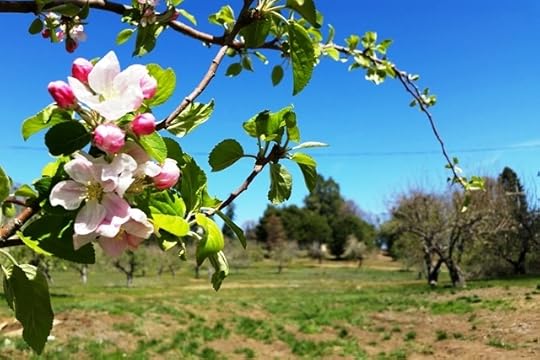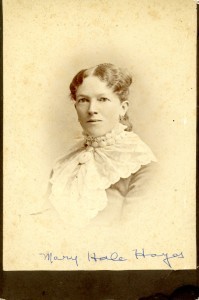Barbara Anne Waite's Blog, page 2
September 3, 2016
Mysterious Letter From Sailor -1864
Mysterious Sailor Frederick Tietz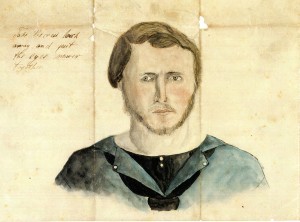
Among Elsie’s treasured papers was a letter from a US Navy man named Fred, written in 1864 to Elsie’s Aunt Annie. From age eighteen Annie Malvina Gilman worked in Washington D. C. When she was 20 years old she wrote to a sailor, unknown to her personally, fighting in the Civil War. Her widowed mother told her she must write using a fictitious name. So she wrote as Miss Malvin. Aunt Annie’s father had been a Congregational Pastor. He died when Annie was fourteen years old. I wish I knew what she wrote to this sailor. His return letter displayed perfect penmanship, illustrated with a rose and a self-portrait. Here is a transcript of his delightful letter:
“Many a good and strong heart is beating underneath a coarse coat; therefore throw not these lines aside on account of their uncouth appearance, but read before you judge. Eau de Cologne or eau de mille fleurs is not begotten here surrounded by swamps.
It is a perilous enterprise to sail in unknown waters and many a good navigator died in the attempt of exploring new islands, but who does not venture, he can never win. Therefore I send this my fragile craft over to you, in the hope to find a harbor in your heart where I may safely repose myself and put myself into fine sailing trim, to cruise over the wild sea of life, which heaves before me, but which I am not afraid to navigate.
A Sea in which I have been sailing indeed a good while already, and weathering many a tempest, without any damage to my vessel whatever. But here goes for our better acquaintance. First, and foremost, fair lady (Mary I dare not say, and Miss Malvin sounds too business like.) I suppose I have to give you an account of myself; so here is the life of Frederick Tietz, Yeoman at present, on board of the U.S. Schooner Dan Smith, South Atlantic Squadron.
I am, (do not shocked) a Dutchman, a Prussian, born and brought up in Berlin, the capital. Whom always burnt underneath his feet, until at last he went to the grief of his mother and to the joy perhaps of a good many people, who did not like to see their windowpanes broke, or to see a boy walking over their heads in the imminent danger ( as they thought ) of falling to the pavement every minute. He will have climbing enough now said those good people and perhaps they were right, I had enough although not too much of it. That was in 1857 when I was 16 years old. I then first sailed from Prussia, afterwards from Denmark and at last, but not least for it is now three years since I entered the first American ship. But to do myself justice, I did not do so, because I could not get along well in the places I left, but I did it for love of change only.
My plans for the future now are, that I want to pass examination at New York in order to trod – in due time – my own deck, and then to come and obtain you, fair lass, if agreeable, for life, if not to drown all recollections of Miss Malvin and take another.
Now Miss, my account of myself is finished, and may you at least think me worth of an answer, I forgot to tell you that I am only 5 feet and 3 inches high for external appearance I give you my portrait, took before the glass which although it will I daresay, bear not the slightest resemblance to the maker, will do as well as a description, for I never flatter, and woe to him, that comes under my pencil. He can never have a favorable, much less flattering opinion of himself afterwards. In the hope, but I have not been tiresome to you, and in the expectation of an answer I conclude and say farewell, fair lady, and may I address you more cordial next time.
I like gracious manners
But hate etiquette
So if thou shouldest answer
Pray call me,
Your Fred”
I love research. I discovered there was a Frederick Tietz, born in 1841, that joined the U.S. Navy. In Feb., 1864, the Union Navy had its ships near St. Simons Island in a blockade attempt to prevent the Confederates from trading with other countries. The Dan Smith was a wooden schooner that held 33 men and was 87’ long, with two thirty-two pound guns. Two weeks after Fred wrote, his schooner captured the Confederate schooner Sophia. In Dec., 1864, Frederick was appointed Acting Masters Mate and became discharged in May, 1865. So interesting to discover via the internet more about this man than Elsie ever knew. Annie Malvina never married, perhaps she never answered Frederick’s plea.
I love hearing from readers, even if e-mails can’t include lovely penmanship, illustrated with wonderful self-portraits.
Wonderful, mysterious, Fred. I wonder who he finally persuaded to marry him? Research shows there was eventually a Frederick Tietz, Jr.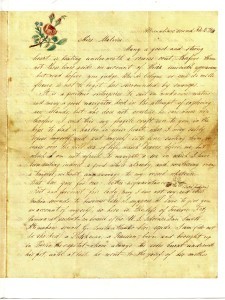
Fred’s Letter to Aunt Annie ( AKA- Miss Malvin)
June 25, 2016
CALIFORNIA FIRE FIGHTING- THEN AND NOW
As I write this “tidbit” today there are six active forest fires burning in California. When I first met my husband, in 1963, he was employed by The US Forest Service, fighting forest fires. Now some 53 years later after seven fire seasons as a volunteer at Boucher Hill and High Point lookouts on Palomar, he is employed once again by the US Forest Service as a fire lookout at Los Pinos tower in Descanso.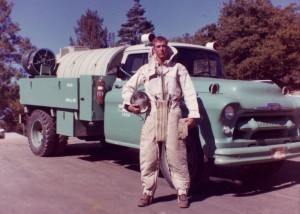
1963- Curt Waite, Helitack Crew US Forest Service -Palomar Mountain
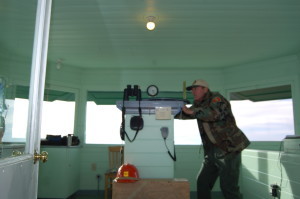
Curt Waite – Fire tower lookout _ Palomar Mountain
The advances in fighting forest fires since Elsie’s days on Palomar in 1904 and 1918 are rather interesting.
In 1911 the government authorized the US Forest Service to provide Fire Protection. In 1919 the State of California provided for salaries for four forest Rangers. By 1920 they had expanded to include salaries for ten rangers.
It was common for the men of the mountain to assist in fighting wild fires. My great grandfather assisted as well as Jack. Elsie rode her burro to warn others of the fire.
In Elsie’s Mountain she wrote about a fire burning:
Aug 29 – 1918:
Mrs. Bailey phoned after supper about fire in woods, started by lightning. Jack helped fight it all evening. Fire- fighting implements are stored at our ranch. Once I took the news on our burro to Silvercrest regarding a blazing fire on the lower part of the mountain. I rode bareback. Papa had gone with the team to save my mountain. I prayed and dug in my heels and galloped to tell the people.
January, 1919:
Jan.10- Jack worked on the telephone line again and Modesto worked on the road while Pete took another load of apples down. The forest fire is not as bad as yesterday and day before. I made nine loaves of bread and a pan of rolls, also made ice cream frozen with snow.
That January fire burned 1,840 acres on Pauma Ranch. I researched that thinking it really was strange to have forest fires in January, yet found it documented elsewhere.
While preparing for this today, I came across an article that would surely be labeled in this day as “politically incorrect.” I suppose it was acceptable in early 1900’s to call a spade a spade.
A U.S. Forest Service pamphlet written in May, 1916, for Fire Suppression for California spoke of the need to evaluate men before hiring to fight a forest fire. It divided men into 4 classes.
“A fair-sized crew contains men who can and will do three or four times as much work as others. Too little attention has been given to careful grading of possible firefighters and the formulating of the proper methods of dealing with each class. The men of any community may be divided into classes, each possessing the qualifications listed below:
Class A: Men worthy of complete confidence; exerting a well-recognized anti-fire influence, possessing superior physical ability and power of endurance.
Class B: Trustworthy men equal to those of Class A, except that they do not possess the qualifications of successful Crew Bosses.
Class C: Trustworthy but ordinary men.
Class D: Shirkers; disorganizers; men without proper shoes; men who are from inexperience or inclination disinclined to respect authority and orders; men suspected of incendiary tendencies or of nursing a fire; men not trustworthy for any other reason.
Class D men should never be hired when it can be avoided. There are circumstances which make it necessary to hire about every known type of Class D men. It is sometimes good policy to make no secret of the fact that a man’s work has caused him to be regarded as undesirable on a control line. More often it is good policy to talk it over in a frank, friendly way with the Class D man himself. No more effective instrument will ever be devised for control of men and affairs than the frank, friendly discussion of a delicate subject.”
I have always considered my guy to be a class A kind of man.
“Elsie’s Mountain,” as an e-book, will be offered FREE on Amazon Kindle from Thursday, June 30 – Saturday, July 2. I hope offering it free for three days generates reviews and increases sales after it returns to a $ 5.99 price.
March 31, 2016
SHARING ELSIE
Sharing Elsie
March is Women’s History Month. How fun to think Elsie’s recorded notes of what life was like 100 years ago is now being enjoyed by so many people. I have been delighted to share her stories with both the Historical Society and Genealogical Society in Temecula. I have shared with one Rotary club and look forward to another in June. Other speaking events are on the calendar and I am looking forward to meeting other history buffs. Here are a couple reviews for “Elsie’s Mountain.” Thanks, readers, for the encouragement of reviews:
“I enjoyed this second book about Elsie, even more than the first one. After reading both books, I feel as though Elsie is my grandmother too. This second book starts out with Elsie’s parents in early Virginia near where Arlington National Cemetery is today, and their life as they moved west to California. It is interesting to see what life was like for people who lived then, and how different California was then compared to how it is today. There are wonderful old photographs throughout the book. I highly recommend this book to anyone who is interested in history, early Virginia and California, as well as anyone interested in genealogy.”
“Elsie’s Mountain takes us back in time in so many ways. Yet it reminds us that “the more things change the more they stay the same.” Anyone privileged to visit Palomar Mountain today will see modern conveniences scattered about, but the flavor of the mountain and the sense of majesty about the place remains timeless. A few gnarled apple trees still exist from Elsie’s original orchard, as does her cozy little home at the bend of the road. The author did not merely copy well preserved journals, she brought them to life in a way that takes the reader to Palomar Mountain to feel the sense of place along with Elsie. This book is not only a compilation of letters and diaries, it is life at it best and sometimes at its most difficult; it is history in the making and history well preserved. Congratulations to Barbara Anne Waite for the loving perseverance it must have taken to gather Elsie’s story into one beautiful book!”
I delighted to receive this email thanking after speaking in Temecula:
“March 14, 2016 was a delightful evening for the members of the Temecula Valley Genealogical Society as we listened to your presentation on Discoveries Made While Writing Two Memoirs. We all enjoyed hearing more about Elsie’s life and the history of life on Palomar Mountain.
Your enthusiasm for telling the story of your ancestor’s life is contagious! I heard many of our members say they were going to get serious about writing their ancestor’s stories. We so appreciated your sharing your expertise on how we could research not only our ancestors but also the time and places they lived so that we could make their stories came alive.
On behalf of the TVGS Board and members, thank you so much! We hope we will have the opportunity to have you return.
Sincerely,
Dotye Summers -TVGS Corresponding Secretary
TREES PLANTED BY ALONZO HAYES IN 1904 STILL GLORIOUS
We retreat to Elsie’s mountain and delight to see the blossoms.
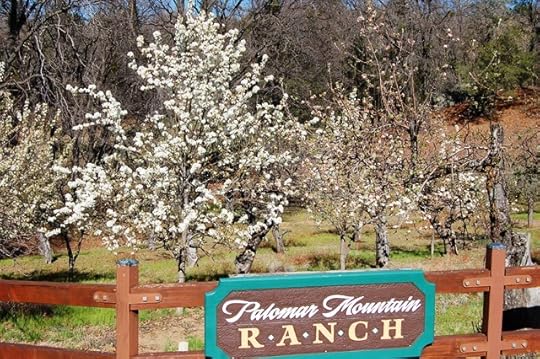
ELSIE’S ORCHARD
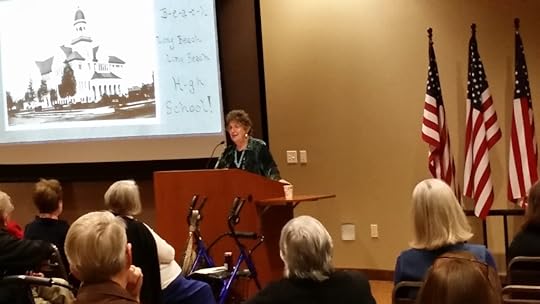
TEMECULA – SPEAKING TO THE GENEALOGICAL SOCIETY
January 16, 2016
Special Drawings for “Elsie’s Mountain” Print Book & E-book Sale
$2.99 E-BOOK “Elsie’s Mountain” – Today ONLY $5 off normal E-BOOK price. Tomorrow will be $3.99. Amazon offering best price today. Adding another dollar to the E-book price each day through Wed. Please share this link for friends who like historical Memoirs. Thanks friends.
http://www.amazon.com/Elsies-Mountain...
Comment on Tidbits to add a chance at drawing for one free print copy of “Elsie’s Mountain.” Requires a mailing address within USA and must comment before Elsie’s Birthday January 22.
Goodreads site will also have drawing starting Jan. 22 for chance at free print copy. Here is the goodreads link that starts Jan. 22:
https://www.goodreads.com/giveaway/sh...
I am enjoying speaking around the county to Historical groups, Rotary clubs and other organizations. Please contact me if you would like me to come share some mountain stories.
Here are a few photos that are favorites. Love that Aunt Mamie is holding a book!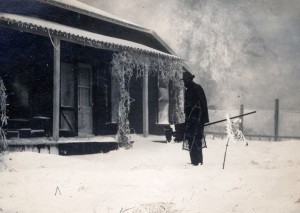
Alonzo, Elsie’s father, during one of the heavy storms on Palomar. Taken by Robert Asher.
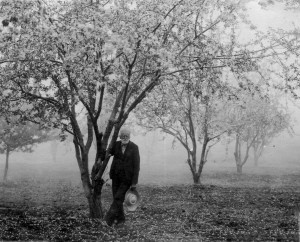
Mr. Cleaver in his orchard. Likely 1904, Robert Asher photo
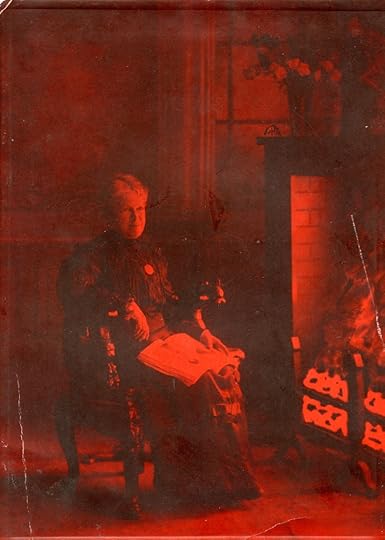
My favorite of Aunt Mamie.
January 5, 2016
Spinster Aunts, Mamie & Annie Hayes
Elsie’s Aunt Mamie. Beloved by all that knew her.
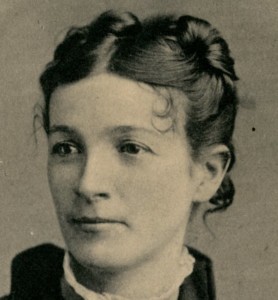
Annie M Hayes- served with the Bureau of Engraving & Printing in Washington, D.C.
I want to share with you a couple Virginia history stories from the new book. I hope you enjoy these tidbits.
To encourage feedback I am going to choose one person to receive a free copy of “Elsie’s Mountain” from those who write a comment on my website before January 22. I will choose them at random, but it must be a mailing address in USA. I will draw the name on January 22, Elsie’s birthday and post it here.
Elsie’s two spinster aunts were remarkable women. Aunt Annie was said to be the first woman with an important post with the government. After her father’s death, when she was only 19 years old, in spite of the Civil War raging near, she went to work in Washington in 1863. She advanced in the Bureau of Engraving and Printing until she was Superintendent of Orders. When President Rutherford B. Hayes came to inspect the Bureau it was Aunt Annie who showed him around. In their chat about their mutual surname they found that they were evidently distant cousins. She had a little autograph album, which was taken to Congress, where it was signed by Lincoln and by several other men who were then members of Congress and who later in turn became presidents of the United States.
This letter from Annie to her brother Alonzo (Elsie’s father), is rather fun. During the winter the two sisters rented rooms near the bureau of Engraving & Printing. The daily buggy ride from Alexandria would have been too cold.
January 30, 1904
1881 Third N.W., Washington, DC
Dear Alonzo,
We had 10 inches of snow yesterday morning and it fell in a day and night. It is now warmer and melting without sunshine. Yesterday it was down to 7° above zero, two above is our lowest we had last week and then it ran to 60° and melted almost, yet not entirely off and then this new one came. The cars [trains] however ran regularly and we had no inconvenience and have been comfortable. We run two large oil stoves all the time we are in the house which adds a good deal to our expense that we did not expect when we rented rooms. But the furnace is totally inadequate and the cans are convenient and we must keep well and feel well to work hard all day so we don’t complain.
I expect you like details of our doings as I do yours. Yesterday the thermometer was seven but did not feel cold. After breakfast I took a car and a transfer to the Ninth Street South and rode to the south side of the market and got out to buy a chicken from the countryman. I can’t bear the thought of those horrid cold storage chickens, undressed. Alonzo knows how they looked stacked on the stands. I got just the nicest little one for $.50, looking as if we had dressed it at home the night before. Then I got on the car and went to the office and put the chicken out in the snow on a north portico until I was ready to go home and stowed him in my pretty red embroidered bag. After office hours I went to get some money orders and bought some bananas and pink Tokay grapes. Sunday we enjoyed a good sermon on the first fifteen verses of Romans.
Love to all, Annie
I wonder if the Bureau still allows workers to store their “nice, little” chickens on the north portico? Wish I had inherited that pretty red embroidered bag to stash my store bought chickens in!
Spinsters Aunts, Mamie & Annie Hayes
Elsie’s Aunt Mamie. Beloved by all that knew her.

Annie M Hayes- served with the Bureau of Engraving & Printing in Washington, D.C.
I want to share with you a couple Virginia history stories from the new book. I hope you enjoy these tidbits.
To encourage feedback I am going to choose one person to receive a free copy of “Elsie’s Mountain” from those who write a comment on my website before January 22. I will choose them at random, but it must be a mailing address in USA. I will draw the name on January 22, Elsie’s birthday and post it here.
Elsie’s two spinster aunts were remarkable women. Aunt Annie was said to be the first woman with an important post with the government. After her father’s death, when she was only 19 years old, in spite of the Civil War raging near, she went to work in Washington in 1863. She advanced in the Bureau of Engraving and Printing until she was Superintendent of Orders. When President Rutherford B. Hayes came to inspect the Bureau it was Aunt Annie who showed him around. In their chat about their mutual surname they found that they were evidently distant cousins. She had a little autograph album, which was taken to Congress, where it was signed by Lincoln and by several other men who were then members of Congress and who later in turn became presidents of the United States.
This letter from Annie to her brother Alonzo (Elsie’s father), is rather fun. During the winter the two sisters rented rooms near the bureau of Engraving & Printing. The daily buggy ride from Alexandria would have been too cold.
January 30, 1904
1881 Third N.W., Washington, DC
Dear Alonzo,
We had 10 inches of snow yesterday morning and it fell in a day and night. It is now warmer and melting without sunshine. Yesterday it was down to 7° above zero, two above is our lowest we had last week and then it ran to 60° and melted almost, yet not entirely off and then this new one came. The cars [trains] however ran regularly and we had no inconvenience and have been comfortable. We run two large oil stoves all the time we are in the house which adds a good deal to our expense that we did not expect when we rented rooms. But the furnace is totally inadequate and the cans are convenient and we must keep well and feel well to work hard all day so we don’t complain.
I expect you like details of our doings as I do yours. Yesterday the thermometer was seven but did not feel cold. After breakfast I took a car and a transfer to the Ninth Street South and rode to the south side of the market and got out to buy a chicken from the countryman. I can’t bear the thought of those horrid cold storage chickens, undressed. Alonzo knows how they looked stacked on the stands. I got just the nicest little one for $.50, looking as if we had dressed it at home the night before. Then I got on the car and went to the office and put the chicken out in the snow on a north portico until I was ready to go home and stowed him in my pretty red embroidered bag. After office hours I went to get some money orders and bought some bananas and pink Tokay grapes. Sunday we enjoyed a good sermon on the first fifteen verses of Romans.
Love to all, Annie
I wonder if the Bureau still allows workers to store their “nice, little” chickens on the north portico? Wish I had inherited that pretty red embroidered bag to stash my store bought chickens in!
October 31, 2015
A Halloween Memory on Palomar Mountain
Work remained a constant companion on Elsie’s mountain. October was one of the busiest months, requiring a large crew to pick and pack the apples. Elsie, of course, had to provide the meals for all the apple pickers. Yet in this excerpt from the book readers can see how, in spite of the work, she remained upbeat and creative. Elsie told her grandchildren this Halloween story year after year.
“Up on our mountain, with no chances to go down, the pickers could hardly have spent the money they were earning. I wonder how they kept contented with so little to entertain them. One fall, we did give them a party that provided a lot of fun for Martha and Sadie, and me at least. It was a surprise Halloween dinner—a surprise in more ways than one.
Sometimes, if not always, a big meal was taken at noon to whatever orchard was being used that day, where perhaps we would join them for a picnic. That day, with the house entirely to ourselves, we decorated it lavishly. Branches of golden oak leaves and rosy sprays of Dogwood were a background. I had some construction paper with which we cut out such appropriate items as cats and witches on broomsticks and tacked them to the walls. We wrote out individual menus, partly humorous, largely in French, indicating that the usually informal meal would be served in as many courses as possible. We made place cards with a personal rhyme to fit each man. Then we prepared a special dinner. We chuckled over everything in anticipation of the surprise.
When the men came in to dinner, they stared about at the decorated walls and table and sat down, startled to find the place cards and menus. Probably a number of them had never heard of such things, much less seen them. They were silent, looking embarrassed. And why wasn’t everything served at once? The courses, one after another, bewildered them further. Our greatest fun had been planning the entrée or what appeared to be the entrée. With an air, Martha brought in a large serving platter with a great rounded oval cover I had inherited, designed to keep a roast hot. She set it down at the head of the table, lifted the cover, and out sprang a very live and very angry black cat! The response was not the shout of laughter we had happily anticipated, but more disgust, or pity for our unbalanced minds. At least the steak that followed was very welcome, as was finally the big cake. Anyway we girls had fun.”
Now, almost 100 years later, I am having such fun sharing “Elsie’s Mountain” with those who never had the privilege to hear her giggle as she told her tales of life on Palomar.
I was privileged to be able to do this at the annual Apple Festival on Palomar Mountain this month. On Oct. 26th the Temecula Historical Society invited me to spend an hour telling Elsie’s stories. I look forward to speaking to the Historical Society in Ramona and other nearby groups. Next Saturday, November 7th, I will be at Bates Brothers Nut Farms selling books and telling tales. The first 100 copies of “Elsie’s Mountain” have sold or been given to potential reviewers in the last 2 weeks. I still have a supply to mail to friends interested in the special November price. It sells on Amazon for $15.00. During November I will mail to those within the USA for $12. I am looking forward to hearing from those who have read and enjoyed. 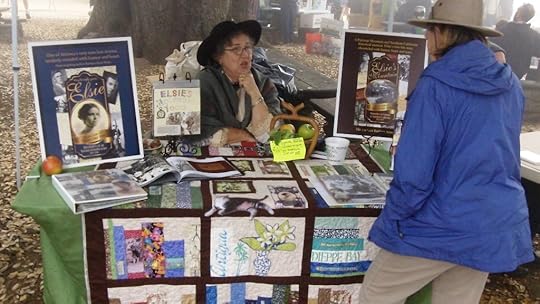
Palomar State Park Annual Apple Festival
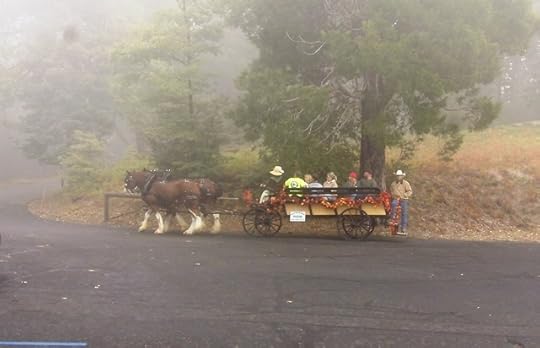
Apple Festival Fun
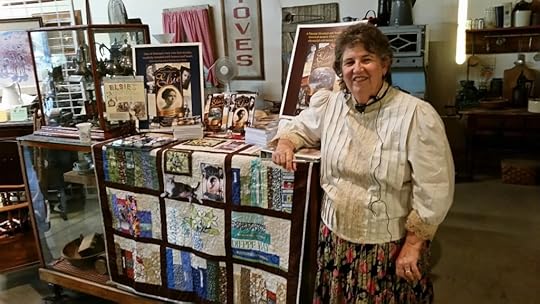
Special Thanks to Lynda Ruth for helping me complete this “Elsie ” quilt.
September 30, 2015
Vintage Photos help tell a story
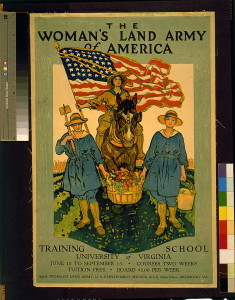
Elsie served as part of the Women’s Land Army during WW l. Love this poster.
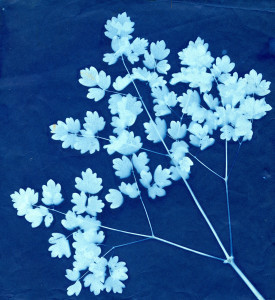
These images of leaves placed on cyanotype paper was a process that began in 1842. Rather like a “blue print” The paper was coated with chemicals and allowed to dry in the dark. Then plants were placed on the paper in the sun and this lovely blue background with an image of the plant appeared. This is one Elsie created over 100 years ago and it is still fabulous.
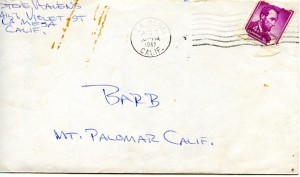
Read Elsie’s story and find out about this letter delivered to me on Palomar Mountain.
September 28, 2015
“Elsie’s Mountain”- Memories of Palomar & Southern California 1897- 1987
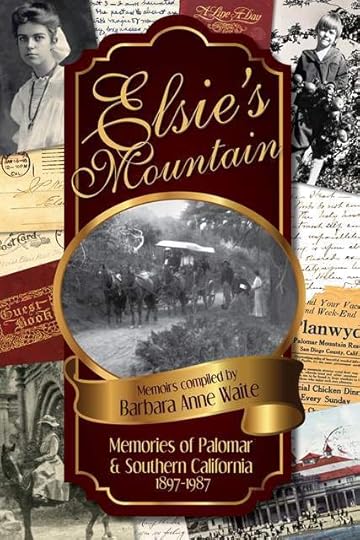
Available from Amazon or my website, starting Oct 18th.
Many have asked to hear more of Elsie. Here is the rest of the story; it will be available Oct.18th. Watch for news about free shipping during November.
Here is an excerpt from her story about the British cooks that Jack particularly liked to hire. I must have heard her tell this story hundreds of times. She never failed to giggle while explaining about this British cook.
Hired Help at Planwydd
Mountain life, during 1918-1924, seemed wilder and more isolated than today. One cook was with us only a few days.
“I’d stay if there was only a movie up here,” she explained, “or sidewalks, so I could go for a walk.”
Usually Jack hired all help through a San Diego employment agency—apple pickers as well as a summer cook and waitresses who also served as chambermaids.
Altogether, during those five years on the apple-ranch, we had a variety of kitchen helpers. One fall apple season, we had two cooks and two dishwashers. One spring, I wrote to my old friend the Dean of Women at Pomona College to ask if she knew of two college girls there who would like to work for me the coming summer. The two who came were Bethel, whose father was a very well-to-do farmer in the Midwest; and Lois, educated in Switzerland, whose father was Minister Plenipotentiary to Albania. They were charming girls, willing workers though they knew practically nothing about housework. They were waitresses, dishwashers, and chamber maids. The guests were delighted with them. But the current cook, Mrs. Miller, very English, could not appreciate them. She was accustomed to work in an English household where there were 17 servants. In those days when servants were servants with their own ranks of butler, housekeeper, cook, etc. and much above the mere maids, she could not endure our casual democratic way of life.The guests were charmed by Bethel and Lois and, of course, treated them as equals. But Mrs. M. felt that as maids, they were far beneath her. She knew her own place, way down below the guests. How could the guests treat those girls as equals? She was pathetically jealous of them. We had explained that we didn’t want tips given at our little all in the family resort. But Mrs. M, accustomed to being one of a line of servants waiting expectantly, almost held her hand out ready whenever a guest was departing.
She never forgot her place. When we had dinner served picnic style on Inspiration Point, I told her she was to sit on the ground with the rest of us and only to help pass things around. It was almost more than she could bear.
At one meal, when luncheon guests had left the room and only the family table was still occupied, she came in from the kitchen, and as always stood quietly waiting to speak until she was noticed. I can still see her subservient attitude and hear her low differential voice.
“Excuse me Mrs. Roberts, your house is on fire.”
As nothing about her suggested that this was a fact, I couldn’t take it in at first. “What did you say?” I asked.
She repeated it, quiet, unemotional, as befitted a servant. To her obvious horror, I did not act as the dignified lady of the house should. I yelped and sprang up and raced for the kitchen. It was true. The kitchen roof was blazing, though already Jack and Gus had it under control.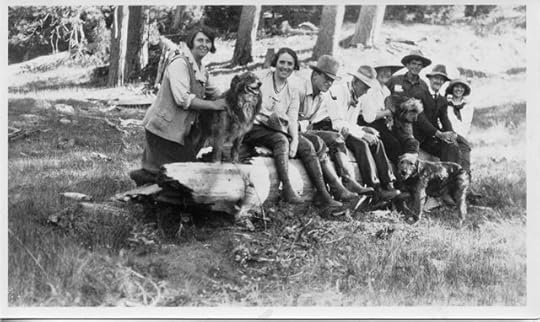
Gus Weber with the hired staff one summer. Robert Asher photo
April 18, 2015
Seasons of Life
Seasons
I suppose one of the surprises of looking closely at my Grandmother Elsie’s life is realizing how aware I am now of the differing seasons of her life. I was age five when she retired as a librarian for the Elementary schools. She then spent several years working as a librarian at a private girl’s boarding school in Glendora. She lived in a dorm and I can still hear my father calling out “Man in the hall!” when we went to visit. By the time I was eight she was living in her small bungalow about ½-mile from my parents and enjoying her retirement. Neither she nor my mother drove a car. I remember walking to visit her and finding her lounging in the shade of a lovely tree on the back patio either writing a story or reading. I never recall her cooking or cleaning house. She was retired. Retired and enjoying her season of time to do what she wanted. It was during those years of retirement that she wrote many published children’s stories and began writing down her own memories about the apple season of her life. She rented one room of her compact 2 bedroom home to a teacher. So there was not much to care for. It is such a sharp contrast to the season of owning and operating the apple ranch on Palomar that I am reading about in her diary. The years between 1918 and 1923 were a time of daily tasks – consideration always had to be given to preparing meals for numerous people. Those meal preparations meant doing everything from scratch, baking bread, canning fruit,etc. Laundry was a hand cranked washing machine. It was a season of picking and drying apples, feeding other apple pickers and serving as the postmistress three days a week.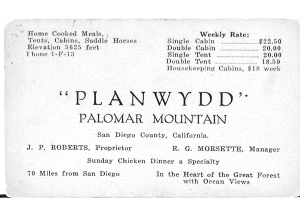
Jack & Elsie’s Resort
Since I can only remember her in the calm, quiet season of retirement, reading her diary gives me a view into that season of her life. Two of our grandchildren just came for a five-day visit. I am wondering how they will remember me years from now. Will picking roses and blueberries and reading “Green Eggs and Ham “in a silly, rapid fire voice be all that they remember of me? My fondest memories are not of her reading me books but of her telling me true stories, many of them from that busiest of sweet seasons of her life. Thanks for the rich memories Grammy Elsie.
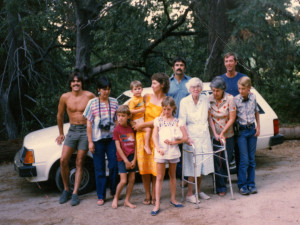
About 1984. Elsie with our family on Palomar. She was still coming up her mountain even at age 96.

